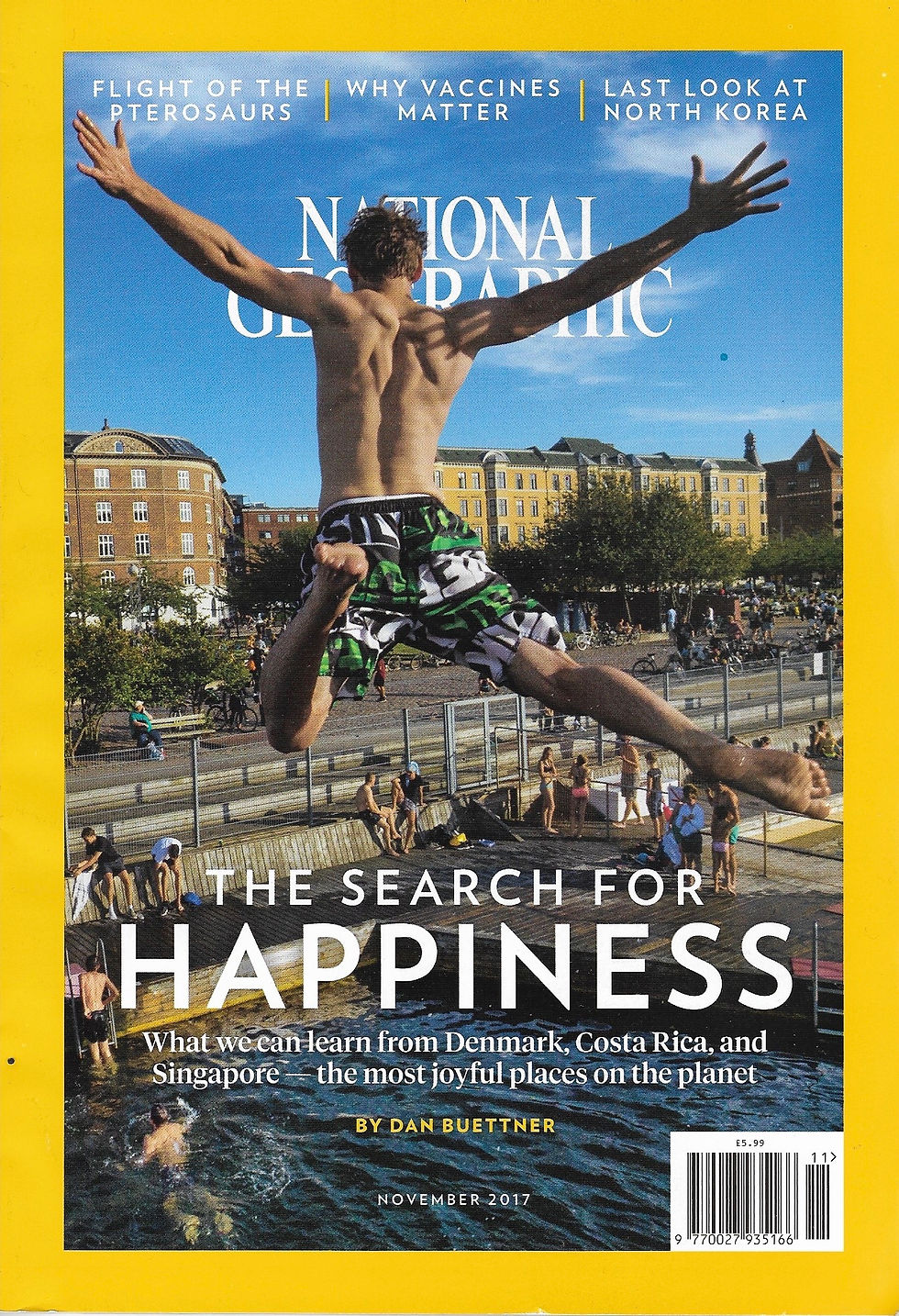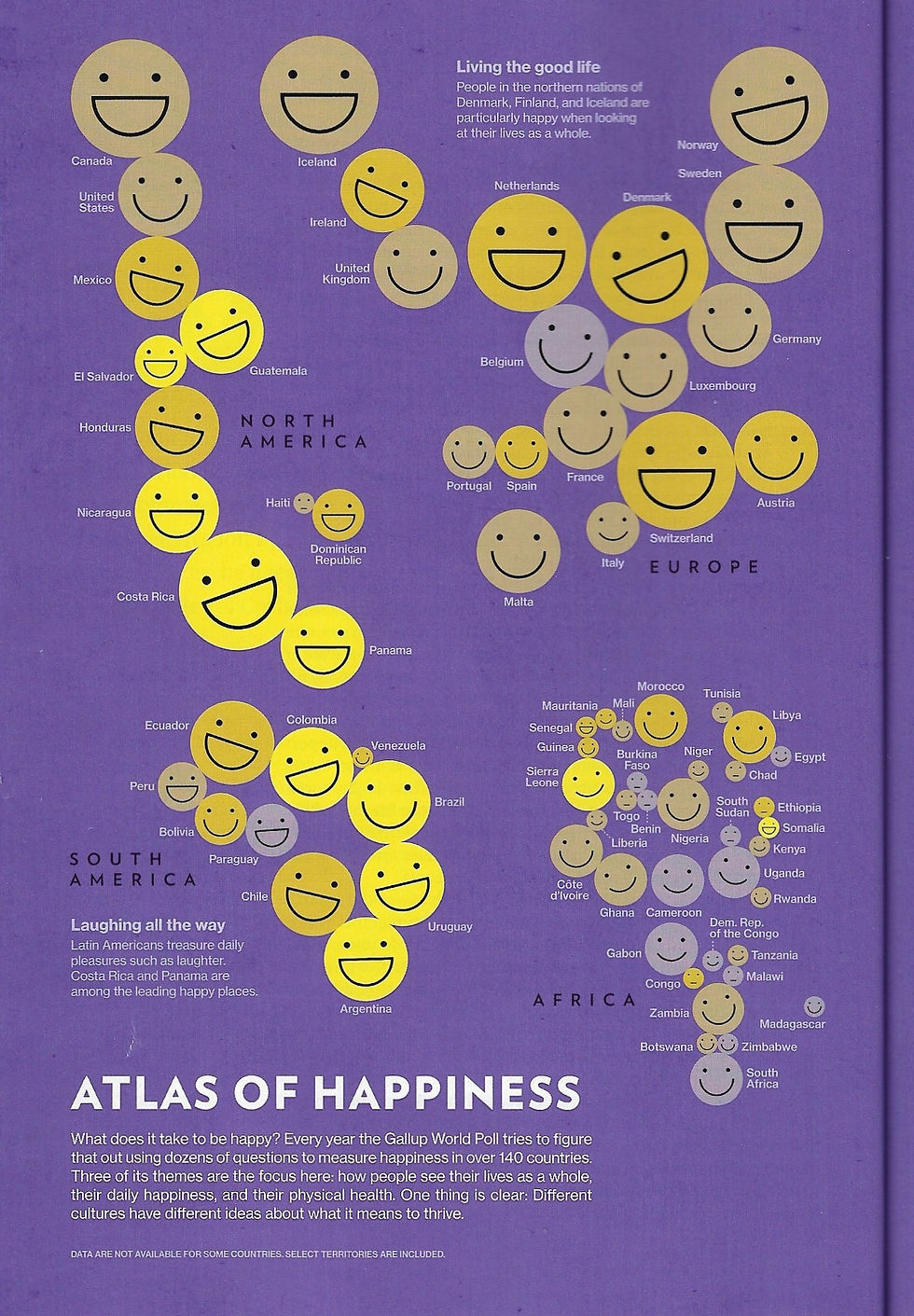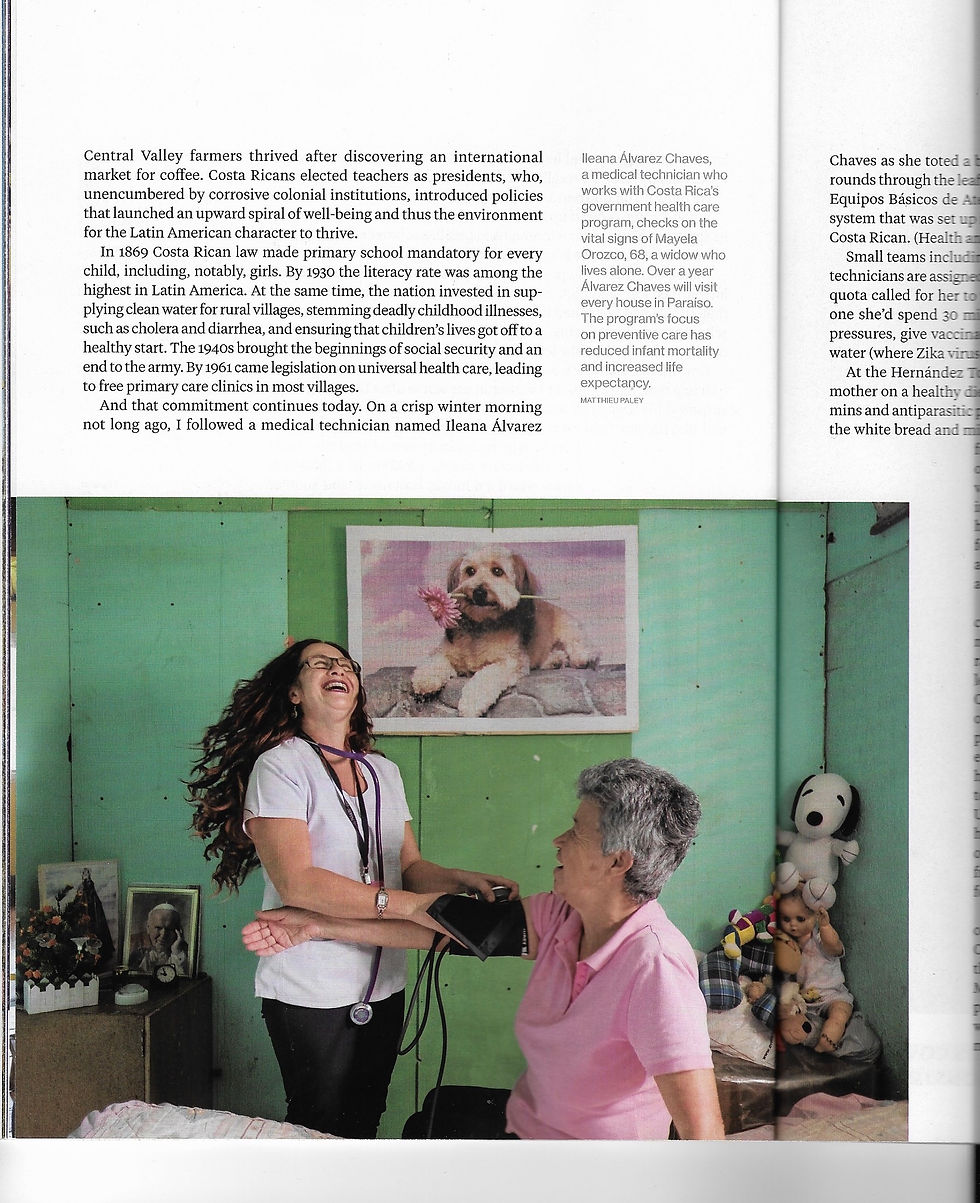30) National Geographic 'The Search of Happiness' November 2017 issue research - 19/11/17
- Alice Lock
- Nov 20, 2017
- 7 min read
On the way to Paris I was browsing the magazines in the waiting area for the Eurostar and came across this National Geographic issue dedicated to the search of happiness. Of course I had to pick it up and buy it, because of how it so closely relates to my project!

Throughout the issue it focuses in on the world's happiest places and why they're so happy and how we as readers can learn from this. The issue focuses specifically on Denmark, Costa Rica and Singapore. Also in the article it features an 'Atlas of Happiness' and an article on who is the happiest person.
Here below pictured is the atlas of happiness, with each country or continent in the world being represented by a smiley face. Its size depends on life as a whole (above 7 is thriving), the colour depends on physical wellbeing (with brighter being better), and the expression is down to daily happiness (scaled from 0 to 100). I think the faces are a great way to depict happiness, because they're easy to compare to each other with simple features such as colour, expression and size. A lot of the smiley representations shocked me, for instance I thought the physical wellbeing of the UK would be higher due to the NHS, and I didn't expect Costa Rica to be such an all round happy place - purely because I haven't heard much about life there. It's also interesting to see how the majority of North and South America are happy, whereas the majority of Europe are not.


The article below focuses on the world's happiest person, and on the first page it mentions 3 different people, all happy but all with very different lives. The first is Alejandro Zuniga, who makes daily choices that favour happiness. For instance enough exercise, sleep, healthy eating, only working 40 hours a week, lots of time socialising, volunteering and worshipping God (experienced happiness or positive effect). The next person is Sidse Clemmensen, who lives in a co-housing community, has a job she loves as well as a loving family. She also pays high taxes to ensure great healthcare and education standards for herself and her children (eudaimonic happiness). Finally is Douglas Foo, who has a family and lots of money for nice possessions such as a car and a house. He also works at least 60 hours a week for his own company that he initially worked 4 jobs for to get started (evaluative happiness). As you can see these are 3 very different types of people, and each person has been labelled with a different type of happiness in this article.
The writing goes on to talk about what factors ensure happiness, and how they stem from your geographical location of where you're living in the world and your country's government and cultural values. The factors include strong economic growth, healthy life expectancy, quality social relationships, generosity, trust, and freedom to live the life thats right for you. These factors make up for 3/4 of your happiness.
The article closes by concluding that these three happy people are happy because of the places they live, mixed with the fact that they pursue goals, accomplish them, while not ignoring time for joy and laughter. As much as I know this is fact and has been researched thoroughly, I don't fully agree that your environment is one of the most contributing factors for happiness, and I like to think that you are in charge of your own happiness regardless of where you live and whether this helps or not. For instance, it is said that only10% of our happiness is allocated to your circumstances - where you live, income, social status, age, whereas 40% is allocated to intentional activity, what you choose to do that makes you happy. Then the remaining 50% is a genetic set-point/range for each person, which we adjust back to in good and bad situations. I speak about this more in a previous blogpost which you can find here.


The article next goes on to focus in on each happy country it has mentioned, with the first being Costa Rica (scans below). The article goes back to Alejandro Zuniga and how he finds his happiness, with the first example being a true representation of how you do not need to find your happiness in materialistic and money-driven ways. Alejandro shows this from his story of giving away the money he won from a lottery ticket, 50 million colones to be exact (around $93,000). He gave it away to the people who meant most to him, such as the friend that sold him the lottery ticket, his food stall owner who fed him in his poorer times, and family. You can understand these motivations when looking closer into the cultural ideas of the location. For instance in the article it says "Costa Rica ... has created a powerful blend of family bonds, universal health care, lasting peace, equality, and ... generosity". Through this mix of ideals that are "all statistically associated with well-being (it) delivers more happiness per GDP dollar than just about anywhere else". Another factor I found interesting that also influences Costa Rica's overall happiness and wellbeing is the introduction of compulsory schooling, and how they "elected teachers as presidents, who, unencumbered by corrosive colonial institutions, introduced policies that launched an upward spiral of well-being and thus the environment for the Latin American character to thrive". I think having leaders whose ideas and thoughts reflect those of the people can really influence the country as a whole and for the better. Health is also another contributing factor to happiness, and "the nation's health care system works so well because it aims to keep people healthy in the first place". This is positively better than health care systems in other places such as the US where their incentives "are aligned to drive up costs".






The next area the article focuses on is Denmark, and scans are inserted below. The article goes back to Sidse Clemmensen, whose happiness partially depends on the co-housing community she lives in, allowing her to live a "purposeful life better than anywhere else". This has developed a community based on people being public and private, also drawing from notions such as generosity and trust for it to work well. Other factors that influence happiness in Denmark includes the high taxes (between 41 and 56%) which allow for people to have health care, education and parental leave all accounted for by the government. Self-fulfilment is also of importance to the Danes, with them working "on average less than 40 hours a week, with at least 4 weeks of vacation a year". This allows time for people to volunteer and get involved in clubs and hobbies, which "encourages a balance between engaging work and rewarding play that results in a sense of time described as flow". The country as a whole seems interested in the total needs of a person even pas their basic needs which I really like. It almost seems like utopia compared to the UK.




The next country in the article focusing on happiness is Singapore, and you can see the scans below. This section brings us back to Douglas Foo, whose happiness I found quite unique and interesting. This is because he works 14 hour days, yet still manages to balance this out by volunteering at over 22 places, while also being able to hold "a wide-mouthed, back-tilted howl of joy". It seems in Singapore, happiness is found by following the rules to put it in basic terms. For example the article states "Success for Singaporeans lies at the end of a well-defined path: Follow the rules, get into the right school, land the right job, and happiness is yours". I think this is so unique in comparison to other places in the world, because people usually associate this hard-working non-stop way of living life with being over-worked, unhappy and lonely, however Singaporeans still say they "feel safe and trust one another". I've also taken away from the article that the Singaporeans combat their happiness by ensuring no ethnicity has the upper hand, for instance "by law .. buildings must reflect the ethnic diversity of the country - so Singapore has no racial or ethnic ghettos". Overall people in Singapore represent a strand of happiness labelled "life satisfaction". You have achieved this if "you're living your values and are proud of what you've accomplished. You tend to be financially secure, have a high degree of status, and feel a sense of belonging".






The article finishes up by talking about where the happiest place in the US is (see scans below). The writing focuses in on individual Ruth Wright, age 88, who stopped high rise buildings being built in Boulder Colorado which would interfere with the beautiful mountain views seen there. She stated "'My life's work has been in preserving that', she said pointing to where the pine-dotted Rocky Mountains towered majestically over the rooftops". I was intrigued as to why people live better here than anywhere else in the US, and Wright explains that it's because "Here in Boulder we have a jewel to preserve". One of the factors contributing to their happiness was the development of 300 miles of bike routes, which seemed to have a great knock on effect of many other factors relating to happiness. For instance, once people were biking around more, it meant they were getting more exercise, reducing pollution and giving cleaner air, while also allowing for less accidents. Another influence of their happiness seems to be their focus on healthy eating. For instance, "Last year Boulder became one of the nation's first cities to approve a soda tax aimed at reducing the consumption of sugar-sweetened beverages". Their genius doesn't even stop there, because they're going to use this money saved with taxes to fund health programs for children. I love how focused on the future and everyone's wellbeing they are here in Boulder, and I think it really strongly reflects into the happiness of the people. It seems weird to me how these changes seem like such small details in people's lives, and its crazy to see the big effect they have if everyone follows it. The article closes by concluding the people of Boulder have three strands of happiness "Pleasure, purpose and pride".




I'm so pleased I picked up this National Geographic copy, because it has so much unique and interesting information about factors that improve happiness in various different places. I found it intriguing how it differs in different geographic locations, and I feel governments just need to find the best way of utilising their area to maximise happiness for them. For instance the way people find happiness in Singapore (in a more career based, money-driven way) in comparison to how people find happiness in Costa Rica (based around other ideals such as equality through healthcare and education) is largely different, but they both seem to work in their own ways. This has motivated me to not let my happiness project become to rigid or based around certain ideals, I just need to show what makes me happiest and why it works.



Comments